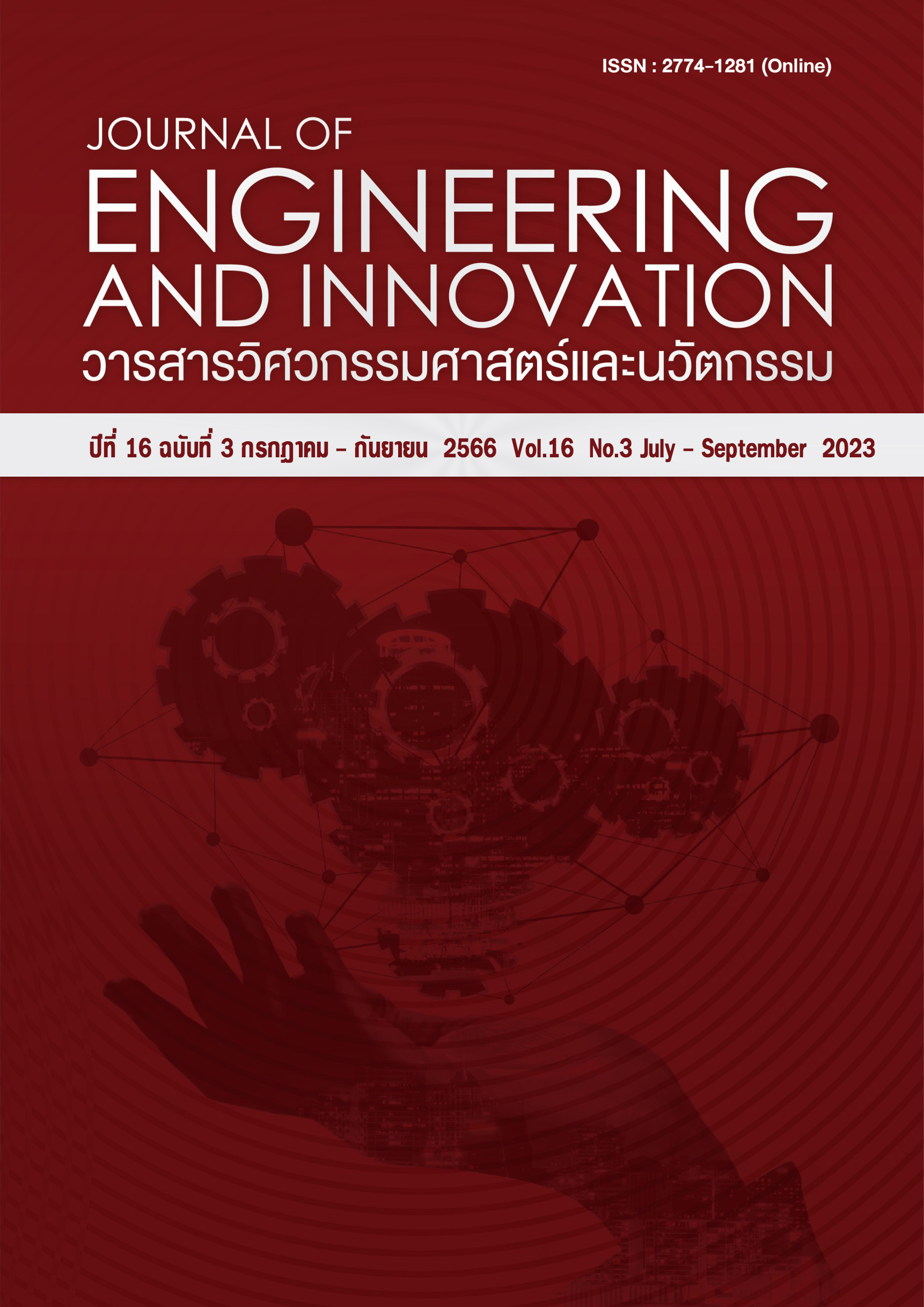The mechanical properties of bamboo used to make ancient umbrellas
Main Article Content
Abstract
The objective of this research is to study the mechanical properties of dried bamboo for use in the structure of ancient umbrellas with constant bending load behavior. The bamboo specimens (Pai Ruak, Thyrsostachys siamensis) from the bottom, middle, and top of the bamboo culm were dried in a bamboo biomass oven at 60 °C and 70 °C to remove moisture from the wood until it is approximately 12.8%wb. The dried bamboo was then subjected to mechanical properties testing with a universal testing machine (UTM) in an air-conditioned room at 25 °C and relative air humidity of approximately 65% to compare with bamboo that has been dried according to the standard test at 103 °C (reference). The average modulus of elasticity and flexural modulus of bamboo dried at 60 °C and 70 °C was less than that of bamboo dried according to the standard test (103 °C) by 38.21% and 18.07% for modulus of elasticity and 35.46% and 24.25% for flexural modulus, respectively.
Article Details
References
ปฏิพล แก้วมะลิวงค์, นครธน ระวังภัย. การพัฒนาเตาเผาขี้เลื่อยสำหรับอบแห้งไม้ที่ใช้เป็นส่วนประกอบของร่มโบราณ. ปริญญานิพนธ์สาขาวิศวกรรมเครื่องกล, คณะวิศวกรรมศาสตร์, มหาวิทยาลัยเทคโนโลยีราชมงคลล้านนา; 2562.
ธีระ วีณิน และ ทรงกลด จารุสมบัติ. ไม้ โครงสร้าง คุณสมบัติ. พิมพ์ครั้งที่ 2. ประทุมธานี: สำนักงานพัฒนาวิทยาศาสตร์และเทคโนโลยีแห่งชาติ; 2549.
Rao A.N., Dhanarajan G., Sastry C.B. Recent research on bamboos. Proceedings of the International bamboo workshop, October 6-14, 1985, Hangzhou, People’s Republic of China; 1985.
Liese W. The Structure of Bamboo in Relation to its Properties and Utilization. Bamboo and its use International Symposium on Industrial use of Bamboo, Beijing, CHINA, December 1992. p. 7-11.
บุญส่ง สมเพาะ, วัลยุทธ เฟื่องวิวัฒน์, ปิยะวดี บัวจงกล, วรัญญู ราษฎร์เจริญ. คุณสมบัติของไม้ไผ่บางชนิดเพื่อการก่อสร้าง. รายงานวิจัยฉบับสมบูรณ์, สำนักวิจัยและพัฒนาการป่าไม้, กรมป่าไม้, กรุงเทพฯ. 2556.
สุภิญญาลักษณ์ จันทรวงศ์. การศึกษาคุณสมบัติเชิงกลของไผ่ตงเพื่อสร้างค่ามาตรฐานกลางของวัสดุและการประยุกต์ใช้ในงานโครงสร้างสำหรับอาคารสาธารณะ. วิทยานิพนธ์สถาปัตยกรรมศาสตรมหาบัณฑิต, คณะสถาปัตยกรรมศาสตร์และการผังเมือง, มหาวิทยาลัยเกษตรศาสตร์; 2557.
ธวัชชัย อุ่นใจจม, นฤมล มณีอินตา, วรวัฒน์ ปัญญาคำ. สมบัติเชิงกลของไม้ไผ่ที่ผ่านการอบแห้ง. วารสารวิศวกรรมศาสตร์ มหาวิทยาลัยศรีนครินทรวิโรฒ. 2560; 12(2): 8-14.
Kitti Chaowana, Supanit Wisadsatorn, Pannipa Chaowana. Bamboo as a sustainable building material-culm characteristics and properties. Sustainability. 2021, 13(7376). Available from: https://doi.org/10.3390/su13137376/ [Accessed 25th April 2022]. Note: articles published online may not have page numbers.
มงคล นามลักษณ์, พิเชษฐ์ เมฆแสน. อิทธิพลของข้อปล้อง ขนาดหน้าตัด และปริมาณความชื้น ต่อกำลังรับแรงดึงของไม้ไผ่. วารสารวิชาการเทคโนโลยีอุตสาหกรรม. 2557; 9(2): 84-96.
ISO. (2019). Bamboo structures-Determination of physical and mechanical properties of bamboo culms-Test methods. ISO/DIS 22157-1:2019(E). Switzerland: International Organization for Standardization.
Hibbeler R.C. Mechanics of materials. 9th edition. New York: Pearson Prentice Hall; 2014.
ASTM. (2011): Standard test method for flexural properties of polymer matrix composite materials. ASTM D7264/D7264M-07. West Conshohocken, PA: ASTM International.

